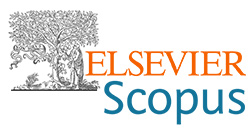Investigation of the performance of activated carbon derived from ripe plantain peels for CO2 capture: Modelling and optimisation using response surface methodology
DOI:
https://doi.org/10.62638/ZasMat1149Apstrakt
This study investigates the potential of activated carbon derived from ripe plantain peels (PPAC) for carbon dioxide (CO2) capture. PPAC was prepared through carbonization and activation using H3PO4, and its unique properties were extensively characterized which revealed irregular sponge-like protrusions and well-defined pores under Scanning Electron Microscopy (SEM). Elemental analysis identified carbon, silicon, and oxygen as major components, corroborated by X-ray Diffraction (XRD) analysis indicating the presence of silicon oxide (SiO2), potassium oxide (K2O), and calcium oxide (CaO). Fourier Transform Infrared (FTIR) spectroscopy highlighted diverse functional groups on PPAC's surface. CO2 adsorption tests were conducted at 27°C and 40°C with varying pressures on PPAC particles of 150µm and 845µm sizes. Results revealed that CO2 adsorption capacity increased with escalating pressures. Remarkably, at 27°C, PPAC exhibited superior performance than at 40°C, attributed to a higher-pressure drop enhancing the driving force for CO2 adsorption. Larger particles (845µm) demonstrated higher adsorption capacity due to increased surface area, enhanced pore accessibility, and faster mass transfer. The Response Surface Methodology (RSM) conducted gave 2FI model as the most representative of the design data and showed high accuracy (R2=0.9973) and low error metrics (MSE=0.01697, RMSE=0.130269, MAE=0.109, MAPE=2.7244). The Adeq Precision value of 76.26 validated the model's reliability. Optimization using RSM yielded optimal CO2 adsorption values (9.69 mmol/g) at 27°C and 100 bars. PPAC emerges as a promising solution for CO2 capture, offering valuable prospects in mitigating emissions and addressing climate change challenges.
Ključne reči:
Ripe Plantain peel activated carbon, Response surface methodology, Characterization, optimisation, CO2 adsorptionReference
A.H.Jagaba, I.M.Lawal, A.A.Ghfar, A.K.Usman, N.S. Yaro, Noor, A.HBirniwa (2023) Biochar-based geopolymernanocomposite for COD and phenol removal from agro-industrial biorefinery wastewater: Kinetic modelling, microbial community, and optimization by response surface methodology. Chemosphere, 339, 139620. https://doi.org/10.1016/j. chemosphere. 2023.139620
C.U.Uzoho, I.F.Okorafor, D.O.Olomu, N.E.Achilike, O.D.Adesina, M.O.Onyekonwu (2023) Determination of Minimum Miscibility Pressure Between Heavy Oil–Supercritical Carbon Dioxide System Using the Slim Tube Method. In SPE Nigeria Annual International Conference and Exhibition (p. D021S002R001). SPE.
A.H.Jawad, A.S.Abdulhameed, T.A.Khadiran, Z.A. Othman, L.D.Wilson, S.Algburi (2023) Response surface methodology for optimizing methylene blue dye removal by mesoporous activated carbon derived from renewable woody Bambusoideae waste. Int. J. of Phytoremediation, 26(5), 727-739, https://doi.org/10.1080/15226514.2023.2262040.
C.Owusu, E.A.Mends, G.Acquah (2022) Enhancing the physical qualities of activated carbon produced from palm kernel shell via response surface methodology—process variable optimization. Biomass Conversion and Biorefinery, ID 254561779, https://doi.org/10.1007/s13399-022-03595-7
Z.Khoshraftar, H.Masoumi, A.Ghaemi (2023) Characterization and evaluation of low-cost biomass-based-AC for CO2 capture: A review. Case Studies in Chemical and Environmental Engineering, 100373. http://dx.doi.org/10. 1016/ j.cscee.2023.100373
G. Greco, R.L.Canevesi, C.Di Stasi, A.Celzard, V. Fierro, J.J. Manya (2022) Biomass-derived carbons physically activated in one or two steps for CH4/CO2 separation. Renewable Energy, 191, 122-133, https://doi.org/10.1016/j.renene.2022.04.035
M.M.Bade, A.A.Dubale, D.F.Bebizuh, M. Atlabachew (2022) Highly efficient multisubstrate agricultural waste-derived activated carbon for enhanced CO2 Capture. ACS omega, 7(22), 18770-18779, https://doi.org/10.1021/acsomega.2c01528
J.A.Sosa, J.R.Laines, D.S.García, R.Hernández, M. Zappi, A.E. de los Monteros (2023) Activated Carbon: A Review of Residual Precursors, Synthesis Processes, Characterization Techniques, and Applications in the Improvement of Biogas. Environmental Engineering Research, 28(3), 220100, https://doi.org/10.4491/eer.2022.100
A.Inam, S.S.Oncel (2021) Photobioreactors as potential tools for environmentally friendly and sustainable buildings. International Journal of Environmental Science and Technology, 19(4), 1-12, http://dx.doi.org/10.1007/s13762-021-03281-7
Z.Khoshraftar, A.Ghaemi (2022) Evaluation of pistachio shells as solid wastes to produce activated carbon for CO2 capture: isotherm, response surface methodology (RSM) and artificial neural network (ANN) modeling. Current Research in Green and Sustainable Chemistry, 5, 100342, https://doi.org/10.1016/j.crgsc.2022.100342.
M.Gorbounov, B.Petrovic, S.Ozmen, P.Clough, S.M.Soltani (2023) Activated carbon derived from Biomass combustion bottom ash as solid sorbent for CO2 adsorption. Chemical Engineering Research and Design, 194, 325-343, https://doi.org/10.1016/j.cherd.2023.04.057
A.Dey, B.Saini, S.C.Balchandani, S.K.Dash (2022) Investigation of equilibrium CO2 solubility in 35 wt% aqueous 1-(2-aminoethyl) piperazine (AEP) and performance study over monoethanolamine for CO2 absorption. Materials Today: Proceedings, 61(2), 498-503, http://dx.doi.org/10.1016/ j.matpr. 2021.12.357
Y.Yang, C.Zhu, Q.Huang (2021) Progress on preparation and adsorption application of solid waste derived hierarchical porous carbon. Chemical Industry and Engineering Progress, 40(1), 427-439, https://doi.org/10.16085/j.issn.1000-6613.2020-0439.
H.Yang, C.He, L.Fu, J.Huo, C.Zhao, X.Li, Y.Song (2021) Capture and separation of CO2 on BC3nanosheets: A DFT study. Chinese Chemical Letters, 32(10), 3202-3206, http://dx.doi.org/10.1016/ j.cclet.2021.03.038
S.Janakiram, J.L.M.Espejo, K.K.Høisæter, A. Lindbråthen, L.Ansaloni, L.Deng (2020) Three-phase hybrid facilitated transport hollow fiber membranes for enhanced CO2 separation. Applied Materials Today, 21, 100801, https://doi.org/10. 1016/j.apmt.2020.100801
Y.Bao, J.Li, Q.Guo, B.Jiang, C.Su (2022) Review on technologies of geological resources exploitation by using carbon dioxide and its synchronous storage. Coal Science and Technology, 50(6), 84-95. https://doi.org/10.13199/j.cnki. cst.2021-0552.
Y.Devarajan, N.Lakshmaiya (2022) Effective utilization of waste banana peel extracts for generating activated carbon-based adsorbent for emission reduction. Biomass Conversion and Biorefinery, 1-7, http://dx.doi.org/10.1007/s13399-022-03470-5
J.Maharjan, V.K.Jha (2022) Activated carbon obtained from banana peels for the removal of As (III) from water. Scientific World, 15(15), 145-157, https://doi.org/10.3126/sw.v15i15.45665
H.Patel, H.Weldekidan, A.Mohanty, M.Misra (2023) Effect of physicochemical activation on CO2 adsorption of activated porous carbon derived from pine sawdust. Carbon Capture Science Technology, 8, 100128, https://doi.org/10. 1016/ j.ccst.2023.100128
J.Serafin, M.Ouzzine, C.Xing, H.El Ouahabi, A. Kamińska, J.Sreńscek-Nazzal (2022) Activated carbons from the Amazonian biomass andiroba shells applied as a CO2 adsorbent and a cheap semiconductor material. Journal of CO2 Utilization, 62,102071,https://doi.org/10.1016/j.jcou.2022. 102071
I.Yanti, P.P.Sationo, W.F.Winata, M.Anugrahwati, A.K.Anas, Y.A.Swasono (2023) Effectiveness of activated carbon magnetic composite from banana peel (Musa acuminata) for recovering iron metal ions. Case Studies in Chemical and Environmental Engineering, 8(4), 100378, http://dx.doi.org/ 10. 1016/j.cscee.2023. 100378
K.Jasri, A.S.Abdulhameed, A.H.Jawad, Z.A. ALOthman, T.A.Yousef, O.K.Al Duaij. (2023) Mesoporous activated carbon produced from mixed wastes of oil palm frond and palm kernel shell using microwave radiation-assisted K2CO3 activation for methylene blue dye removal: Optimization by response surface methodology. Diamond and Related Materials, 131, 109581, https://doi.org/10. 1016/j.diamond.2022.109581
Y.Vasilev, P.Vasileva, A.Tsvetkova (2020) The Study of Spreading Information on Carbon Capture, Utilization and Storage Technologies in the Social Media. 20th International Multidisciplinary Scientific GeoConference Proceedings SGEM, 20(5), 833-839, http://dx.doi.org/10.5593/sgem2020/5.1/s20. 105
Y.Li, G.Zhang, J.Liu, G.Li, Y.Wang (2023) Optimized preparation of multi-matrix activated carbon for CO2 capture by response surface methodology: The advantages of co-pyrolysis of biomass and plastics. J. of the Energy Institute, 101415, https://doi.org/10.1016/j.joei.2023.101415
M.Ounis, E.Sanz-Santos, F.Fakhfakh, M.K. Younes, B.Hadrich, S.Álvarez-Torrellas, J.García (2023) Optimisation of Adsorption Removal of Bisphenol A Using Sludge-Based Activated Carbons: Application of Response Surface Methodology with a Box–Behnken Design. Arabian Journal for Science and Engineering, 49(3), 1-18, https://doi.org/10.1007/s13369-023-08203-y
J.Fito, S.Tibebu, T.T.Nkambule (2023) Optimization of Cr (VI) removal from aqueous solution with activated carbon derived from Eichhorniacrassipes under response surface methodology. BMC chemistry, 17(1), 4, https://doi.org/10.1186/s13065-023-00913-6
Z.Tariq, Z.Xu, M.Gudala, B.Yan, S.Sun (2023 January). Deep-Learning-Based Surrogate Model to Predict CO2 Saturation Front in Highly Heterogeneous Naturally Fractured Reservoirs: A Discrete Fracture Network Approach. In SPE Reservoir Characterisation and Simulation Conference and Exhibition? (p. D021S007R006). SPE. https://doi.org/10.2118/212658-ms
S.Kumar, K.Prasad, J.M.Gil, A.J.Sobral, J.Koh (2018) Mesoporous zeolite-chitosan composite for enhanced capture and catalytic activity in chemical fixation of CO2. Carbohydrate Polymers, 198, 401-406, https://doi.org/10.1016/j.carbpol.2018.06.100
D.Chaturvedi, O.P.Misra (2019) Modeling impact of varying pH due to carbondioxide on the dynamics of prey–predator species system. Nonlinear Analysis: Real World Applications, 46, 374-402, https://doi.org/10.1016/j.nonrwa.2018.09. 024
A.Mukherjee, B.Saha, C.Niu, A.K.Dalai (2022) Preparation of activated carbon from spent coffee grounds and functionalization by deep eutectic solvent: Effect of textural properties and surface chemistry on CO2 capture performance. Journal of Environmental Chemical Engineering, 10(6), 108815, http://dx.doi.org/10.1016/j.jece.2022. 108815
N.H.Sabri, N.H.A.Rani, N.F.Mohamad, N.M. Muhsen, M.M.Zaini (2023) Simulation of CO2 capture for amine impregnated activated carbon-palm kernel shell (AC-PKS) adsorbent in pressure swing adsorption (PSA) using Aspen Adsorption. Materials Today: Proceedings, https://doi.org/10.1016/j.matpr.2022.12.206
H.Vogtenhuber, R.Hofmann, F.Helminger, G. Schöny (2018) Process simulation of an efficient temperature swing adsorption concept for biogas upgrading. Energy, 162, 200-209, https://doi.org/10.1016/ j.energy.2018.07.193
R.Maniarasu, S.K.Rathore, S.Murugan (2023) Biomass-based activated carbon for CO2 adsorption–A review. Energy & Environment, 34(5), 1674-1721, https://doi.org/10.1177/0958305X221093465
A.Helmi, F.Gallucci, M. van Sint Annaland. (2014) Resource scarcity in palladium membrane applications for carbon capture in integrated gasification combined cycle units. International journal of hydrogen energy, 39(20), 10498-10506, https://doi.org/10.1016/j.ijhydene.2014.05.009







